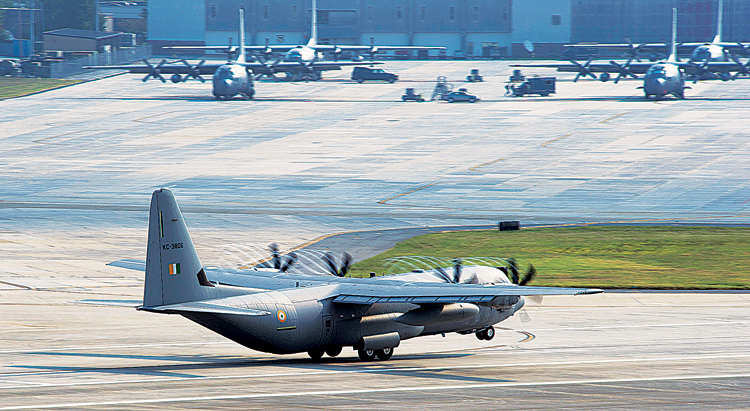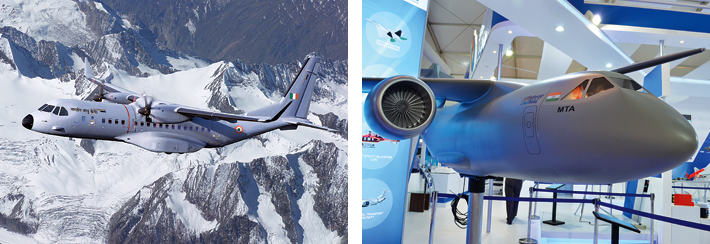INDIAN ARMED FORCES CHIEFS ON
OUR RELENTLESS AND FOCUSED PUBLISHING EFFORTS

SP Guide Publications puts forth a well compiled articulation of issues, pursuits and accomplishments of the Indian Army, over the years

I am confident that SP Guide Publications would continue to inform, inspire and influence.

My compliments to SP Guide Publications for informative and credible reportage on contemporary aerospace issues over the past six decades.
The Versatile Transport Fleet of the IAF
Over the years and with the gradual accretion of platforms and capabilities, the IAF has developed world class expertise in diverse force multiplier roles

THE CAPABILITY
Attributes of speed, reach, flexibility, versatility, concentration of force and responsiveness to the fighting forces is provided by the IAF’s Air Transport fleet. Carriage of military equipment between theatres for routine deployments, reinforcement and evacuation of stranded personnel and diaspora from troubled spots around the globe is a demonstrated role of the IAF. Over the years and with the gradual accretion of platforms and capabilities, the IAF has developed world class expertise in diverse force multiplier roles. Among these are Special Operations, Air-to-air refuelling (AAR), Airborne Warning and Control Systems (AWACS), Intelligence, Surveillance and Recce (ISR), Casualty Evacuation (CASEVAC), Search, Rescue, Mercy Missions and Airborne Command Platforms for National Leadership.
HISTORY ON THE WALL
The First India-Pakistan Conflict
On October 27, 1947, three Dakotas carrying troops of the First Battalion of the Sikh Regiment (1 SIKH) touched down in Srinagar in the nick of time to save the airfield from imminent capture by advancing lashkars (tribal armies) embedded with regulars from the Pakistan Army. The Daks, as they were affectionately called, flew incessantly for the next three weeks without oxygen and de-icing equipment, both considered an absolute necessity for operations at high altitudes and cold weather, as they inducted 161 Brigade into the Kashmir Valley. In 1947-48, a crisis was developing at Poonch, which was literally under siege as lashkars and the Pakistan Army shelled the town incessantly. Poonch would have fallen by early 1948 had it not been for the timely action by the IAF’s transport fleet. In early 1948, Pakistan launched Operation Sledge to seize the areas of Skardu, Kargil & Zozila and ultimately wrest control of the Leh valley. To foil this attempt, Air Commodore Mehar Singh led the first airlanded task force into Leh as Dakotas from 12 Squadron opened an airbridge to Leh by ferrying in two hundred and fifty soldiers and saved Leh.

Airborne Assault to Capture the Poongli Bridge
One of the key catalysts of the collapse of the Dacca (also called Dhaka) garrison in December 1971 was the psychological impact of the Tangail airdrop. As the Indian Army’s 95 Brigade was advancing on Dacca from the north, it was assessed that a foothold in Tangail would greatly assist the operation. Accordingly, on December 11, 1971, 2 PARA was tasked to launch an Airborne Assault to capture the Poongli Bridge on the river Jamuna. The air assets used by the IAF were large by any standards and were six AN-12, two Caribous, 20 C-119 Packets and 22 Dakotas. The capture of the Poongli bridge gave the advancing Indian Army, the maneuverability to side-step the strongly held main road to Dacca and advance right up to Mirpur Bridge at the gates of Dacca and this was the straw that broke the camel’s back and forced the unconditional surrender of 93,000 troops at Dacca on 16 December 1971.
Innovative use of Transport Fleet for Bombing
To augment its bombing capability, a concept to deploy An-12s for bombing was first mooted in 1967 and this innovative idea was encouraged by the then Chief of the Air Staff, Air Chief Marshal Arjan Singh. The aircraft was configured to carry 28 to 36 - 500-pounders for carpet bombing and on December 3, 1971, six aircraft of the 44 Squadron bombed Pakistan Army’s Changa Manga ammunition depot in the forests for two days. In the next round, a Pakistani artillery concentration around the Haji Pir pass was attacked, and based on intelligence inputs, a Pakistani artillery brigade was wiped out.
Strategic Airlift
The Successful evacuation of 1,11,711 Indian citizens from Iraq, Kuwait and Jordan in 1990 by operating 488 refugee flights over a period of 59 days by Air India and IAF has been a world record. Similar missions were carried out from Lebanon in 2006 (Operation Sukoon), Libya in 2011 and Yemen (Operation Rahat) in April 2015. Operation Rahat, involved the deployment of C-17 aircraft of the IAF and Air India’s aircraft to airlift thousands of people in distress. Once again Indian Nationals were brought back this year when the Russia Ukraine war commenced.
Special Operations & Force Multipliers
IAF force multipliers based on air transport platforms such as Air-Air-Refuelling (AAR), Airborne Warning and Control Systems (AWACS), Airborne Early Warning (AEW), Communication Intelligence (COMINT) and Electronic Intelligence (ELINT) act as tri-service enablers that allow operators to plan and execute missions that were hitherto considered complex and complicated to execute. They have literally changed the way full spectrum operations are planned and conducted. With the induction of airborne tankers in the IAF, combat ranges of fighter aircraft have expanded to cover India’s articulated area of influence from the Malacca Straits to the Gulf of Aden.
The entire Siachen glacier and most posts along the LAC are air maintained by aerial delivery and airlanded operations at forward airfields and Advanced Landing Grounds
The IAF’s ‘Eyes in the Sky’ or AWACS is again a unique aircraft that plugs-ineasily to the IAF’s Integrated Air Command and Control System (IACCS), it offers operators and commanders excellent situational awareness and decision-making tools for the effective conduct of the entire range of offensive and enabling air operations.
OPERATIONAL TERRAIN
India has one of the most diverse landscapes and climatic variations spread across its geographical expanse, all of which challenge the conduct of operations across the spectrum of conflict. To the south, it has vast coastal regions along with island territories. To the west, it has deserts, salt pans and marshy lands. The Northeast has thick and in hospitable jungle and hilly terrain rising to heights between 5,000 and 15,000 feet. To the north, it has the mighty Himalayas, mountains with average height of 20,000 to 25,000 feet. Within this widely disparate terrain lie contested borders that need to be defended, without any respite, by the Indian Army and a sprinkling of border protection forces.

The entire Siachen glacier and most posts along the LAC are air maintained by aerial delivery and airlanded operations at forward airfields and Advanced Landing Grounds.
Assistance during Pandemic
On February 27, 2020, 76 Indians and 36 foreign nationals from Bangladesh, China, Madagascar, Maldives, Myanmar, South Africa and the USA were evacuated from Wuhan (China). The aircraft had also carried medical supplies as symbol of goodwill to China. IAF’s C-17 brought back 58 Covid stranded Indians from Iran on March 10, 2020. Over 1,500 sorties, 3,000 hours and 2 million kilometres. The distance covered is akin to going around the Earth 55 times. These staggering figures are a testimony to how busy the IAF’s Transport Fleet has been in its Covid-19 mitigation efforts.
THE CAPACITY
For the first three decades after independence, the IAF had a mix of An-12 aircraft (10-15 tonnes), Packet Fairchild (4-6 tonnes), Caribou and Dakota aircraft for the Air Maintenance and Logistics support, whereas, Avro with Boeing 737-200 were deployed for strategic communication duties. In the early 1980s, when the entire fleet was in crisis, Avro aircraft were inducted for Air Maintenance and inter-island communications. The fleet was thus modernised with fourteen IL-76 aircraft (40 tonnes) and 124 An-32 aircraft (4-6 tonnes) and led to the decommissioning of An-12, Caribou, Packet Fairchild and Dakota aircraft.
IAF requires a fleet of Medium Transport Aircraft (MTA)
With the rise in National aspiration and an increase in Strategic requirement of India, the Transport Fleet was augmented with C-17 Globemaster aircraft (with a maximum varying capacity of 78 tonnes) and C-130J Hercules aircraft (a tactical aircraft with 20 tonnes capacity). The mid-level An-32 and Avro aircraft will soon be replaced with C295 (6-9 tonnes capacity), 16 aircraft will be flown down from Europe and rest 40 aircraft will be produced by Tatas in India. To complement the above, IAF requires a fleet of Medium Transport Aircraft (MTA).
CONCLUSION
The role of the IAF has been unique in statecraft because of its efficiency to respond fast and its inherent characteristic of range, mobility and flexibility. Other than countless rescue missions within the country, many nations have benefitted from the HADR and Non-Combat Evacuation (NCE) mission capabilities of the IAF’s Air Transport Fleet. The IAF’s strategic airlift capability has repeatedly been demonstrated by the IAF in the IOR region during Operation Cactus at Maldives, Tsunami relief operations, Operation Rainbow for Sri Lanka, Operation Castor and Operation Neer, again in the Maldives. Among other enabling capabilities offered by the IAF’s air transport fleet that acts as strategic instruments of statecraft, these can be effectively leveraged for the collective well being of the region, particularly among India’s maritime neighbours and island states that are the focus of the SAGAR initiative.
The author, in his last appointment, served as Deputy Chief of Integrated Defence Staff and also officiated as Additional Secretary (Air) at DMA, under CDS, MoD. Commissioned on 11 Dec 1981, was alumnus of FIS, CDM and NDC. Cat ‘A’ Qualified Flying Instructor was an Air Force Examiner with over 7200 hours on various Transport and Trainer aircraft. He has served in all the four verticals of HQ IDS at appointments of DACIDS (Regional-DIA), ACIDS (ICT & Joint Ops), DCIDS (Ops), DCIDS (PP & FD) and Commandant College of Defence Management. Co-authored DAP-2020, DPM-2020, DFPDS-2020 and the first Negative Import List at DMA. He retired in September 2020.





